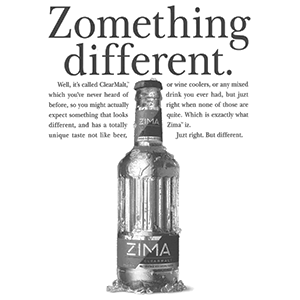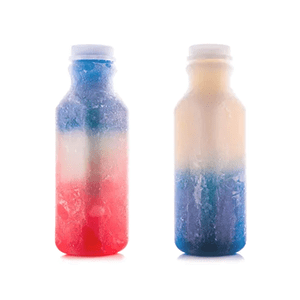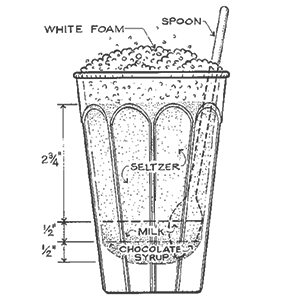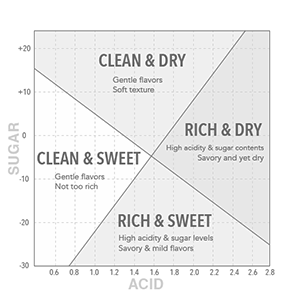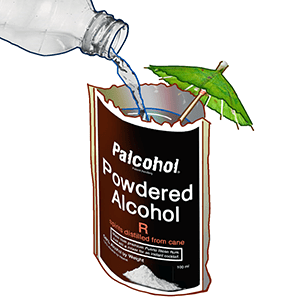Zima Clearmalt was a clear, lightly carbonated alcoholic beverage made and distributed by the Coors Brewing Company. Introduced in 1993, it was marketed as an alternative to beer, an example of what is now often referred to as a cooler, with 4.7–5.4% alcohol by volume. Its production in the U.S. ceased in 2008, but it was still marketed in Japan until 2021. MillerCoors promoted a limited release of Zima in the summers of 2017 and 2018.
Zima means ‘winter’ in Slavic languages. It was launched nationally in the United States as Zima Clearmalt in 1993 after being test-marketed two years earlier in the cities of Nashville, Sacramento, and Syracuse. The lemon-lime drink was part of the ‘clear craze’ of the 1990s that produced products such as Crystal Pepsi and Tab Clear. Early advertisements for Zima described it as a ‘truly unique alcohol beverage’ and used the tagline ‘Zomething different.’
read more »
Zima
Nutcracker
A nutcracker is a type of alcoholic drink consisting of a mixture of hard liquor and sugary beverages such as fruit juice that originated and are made and sold in New York City. Originally sold via word-of-mouth by street vendors, nutcrackers have also been offered as ‘to-go cocktails’ by bars and restaurants.
Nutcrackers frequently consist of liquors such as vodka, rum, tequila and cognac, mixed with fruit juice, Kool-Aid or candy. They are sold mainly during the summer on the streets and on the beaches, and come in cups or small plastic bottles. The sale of nutcrackers without a license violates New York law, and the police have on occasion attempted to sanction it.
read more »
White Coke
White Coke is a nickname for a clear variant of Coca-Cola produced in the 1940s at the request of Marshal of the Soviet Union Georgy Zhukov. Like other clear colas, it was of the same original flavor, virtually unchanged by the absence of caramel coloring.
Zhukov was introduced to Coca-Cola during, or shortly after, World War II by his counterpart in Western Europe, Supreme Commander of Allied Forces in Western Europe, Dwight D. Eisenhower, who was also a fan of the drink. As Coca-Cola was regarded in the Soviet Union as a symbol of American imperialism, Zhukov was apparently reluctant to be photographed or reported as consuming such a product.
read more »
Egg Cream
An egg cream is a cold beverage consisting of milk, carbonated water, and flavored syrup (typically chocolate or vanilla). Despite the name, the drink contains neither eggs nor cream.
The egg cream is almost exclusively a fountain drink. Although there have been several attempts to bottle it, none have been wholly successful, as its refreshing taste and characteristic head require mixing of the ingredients just before drinking.
read more »
Matcha
Matcha [mah-chuh] is finely ground powder of specially grown and processed green tea leaves. It is special in two aspects of farming and processing: the green tea plants for matcha are shade-grown for about three weeks before harvest and the stems and veins are removed in processing. During shaded growth, the plant Camellia sinensis produces more theanine and caffeine.
The traditional Japanese tea ceremony centers on the preparation, serving, and drinking of matcha as hot tea and embodies a meditative spiritual style. In modern times, matcha has also come to be used to flavor and dye foods such as mochi and soba noodles, green tea ice cream, matcha lattes, and a variety of Japanese wagashi confectionery.
read more »
Mezcal
Mezcal (lit. ‘oven-cooked agave’) is a distilled alcoholic beverage made from any type of agave plant native to Mexico. Agave, which is often misidentified as a variety of cactus, grows in many parts of Mexico, though most mezcal is made in Oaxaca, a southern state. A Oaxacan expression regarding the drink is: ‘Para todo mal, mezcal, y para todo bien, también.’ (‘For everything bad, mezcal, and for everything good as well.’)
It is unclear whether distilled drinks were produced in Mexico before the Spanish Conquest. The Spaniards were introduced to native fermented drinks such as pulque, a milky-looking, alcoholic beverage made from the fermented sap of the maguey plant (also known as agave americana). Soon, the conquistadors began experimenting with the agave plant to find a way to make a distillable fermented mash. The result was mezcal.
read more »
Porter
Porter is a dark style of beer developed in London from well-hopped beers made from brown malt. The name was first recorded in the 18th century, and is thought to come from its popularity with street and river porters.
The history and development of stout and porter are intertwined. The name ‘stout’ as used for a dark beer is believed to have come about because strong porters were marketed under such names as ‘Extra Porter,’ ‘Double Porter,’ and ‘Stout Porter.’ The term ‘Stout Porter’ would later be shortened to just ‘Stout.’ For example, Guinness Extra Stout was originally called Extra Superior Porter and was only given the name Extra Stout in 1840.
read more »
Bourbon Whiskey
Bourbon [boor-buhn] whiskey is a type of American whiskey, a barrel-aged distilled spirit made primarily from corn. The name is ultimately derived from the French Bourbon dynasty, although it is unclear precisely what inspired the whiskey’s name (contenders include Bourbon County in Kentucky and Bourbon Street in New Orleans).
Bourbon has been distilled since the 18th century. The use of the term ‘bourbon’ for the whiskey has been traced to the 1820s, and the term began to be used consistently in Kentucky in the 1870s. While bourbon may be made anywhere in the United States, it is strongly associated with the American South, and with Kentucky in particular.
read more »
Apéritif and Digestif
Apéritifs and digestifs are drinks, typically alcoholic, served before (apéritif) or after (digestif) a meal. An apéritif is served to stimulate the appetite, and is therefore usually dry rather than sweet. A digestif is intended to aid digestion. When served after a coffee course, it may be called ‘pousse-café.’ Digestifs are usually taken straight and typically contain carminative herbs, which are thought to aid digestion. ‘Apéritif’ is a French word derived from the Latin verb ‘aperire,’ which means ‘to open.’ The French slang word for ‘apéritif’ is ‘apéro,’ although in France an ‘apéro’ is also light food eaten in the late afternoon/early evening.
Common apéritif choices include dry vermouth, champagne, pastis (an anise-flavored spirit from France), gin, and dry sherry (e.g. fino and amontillado). ‘Apéritif’ may also refer to a snack that precedes a meal. This includes an amuse-bouche (a single, bite-sized hors d’oeuvre), such as crackers, cheese, pâté or olives. Common kinds of digestif include: Brandy, Cream Sherry, Sweet Vermouth, Port, Grand Marnier, Jagermeister, Kahlua, limoncello, ouzo, and tequila. In certain areas, it is not uncommon for a digestif to be taken before a main course. One example is le trou Normand, a glass of Calvados taken before the main course of a meal.
read more »
Pappy Van Winkle’s Family Reserve
Pappy Van Winkle’s Family Reserve is the flagship brand of bourbon whiskey owned by the ‘Old Rip Van Winkle Distillery’ company (which does not actually own or operate a distillery, but rather has it produced under a contract with another company). It is distilled and bottled by the Sazerac Company at its Buffalo Trace Distillery in Frankfort, Kentucky. It is often regarded as one of the finest bourbons in the world, and is rare to find on the market due to its very low production and high demand. The product has a cult-like following. Famous chefs such as Anthony Bourdain and David Chang have favored the product.
‘Food Republic’ reported that Chef John Currence said: ‘There’s Pappy Van Winkle, then there’s everything else.’ Bourbon aficionados have shown up in droves to get a small chance in a lottery to purchase some. It has been called ‘the bourbon everyone wants but no one can get.’ A writer for ‘The Wall Street Journal’ said ‘You could call it bourbon, or you could call it a $5,000 bottle of liquified, barrel-aged unobtanium.’ Jen Doll wrote in ‘The Wire,’ ‘It’s an age-old dilemma (supply and demand) leading to an age-old marketing dream (a product that can’t be kept on the shelves … money in the pockets … bourbon in the bourbon snifters).’
read more »
Alcohol Powder
Alcohol powder is molecularly encapsulated ethanol. The powder produces an alcoholic beverage when mixed with water. According to food chemist Udo Pollmer of the European Institute of Food and Nutrition Sciences in Munich, alcohol can be absorbed in cyclodextrins, a synthetic carbohydrate derivative. The cyclodextrins can absorb an estimated 60 percent of their own weight in alcohol while remaining dry to the touch. A US patent was registered for the process as early as 1974.
Alcohol powder can be used to reconstitute alcoholic beverages or inhaled through a nebulizer (mister). In Germany a product called Subyou reportedly was distributed on the Internet. The product was available in four flavors and packed in 65 – 100 gram sachets. When mixed with 0.25 liters of water it gives a drink with 4.8% alcohol. It was assumed a German producer manufactured the product from imported raw alcohol powder from the US.
read more »
Soju
Soju (lit. ‘burned liquor’) is a distilled beverage native to Korea, typically 20% alcohol by volume. Jinro and Lotte soju are the first and third top selling alcohol brands in the world. It is usually consumed neat. It is traditionally made from rice, wheat, barley, but modern producers of soju use supplements or even replace rice with other starches, such as potatoes, sweet potatoes, or tapioca.
Alcohol etiquette is tied to South Korea’s strict culture of respect, particular for elders. When accepting a glass from an older person, the recipient must hold the glass with two hands (left palm on the bottom, right hand holding the side) and bow the head slightly. When drinking the younger person must turn away from the elder and cover their mouth and glass with their hands. There are a few rules unique to Soju: never pour your own glass, and don’t refill your glass until it’s empty.
